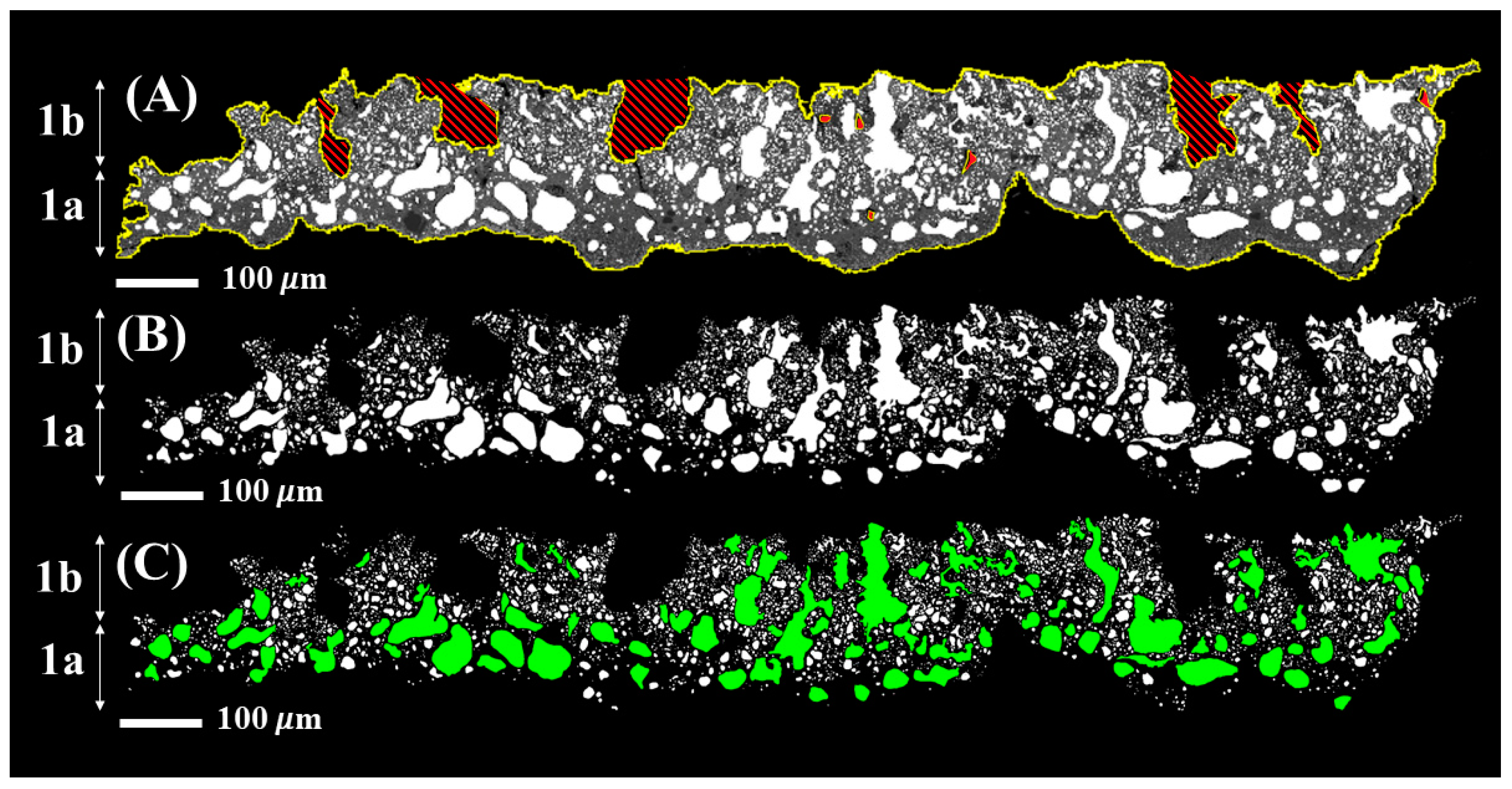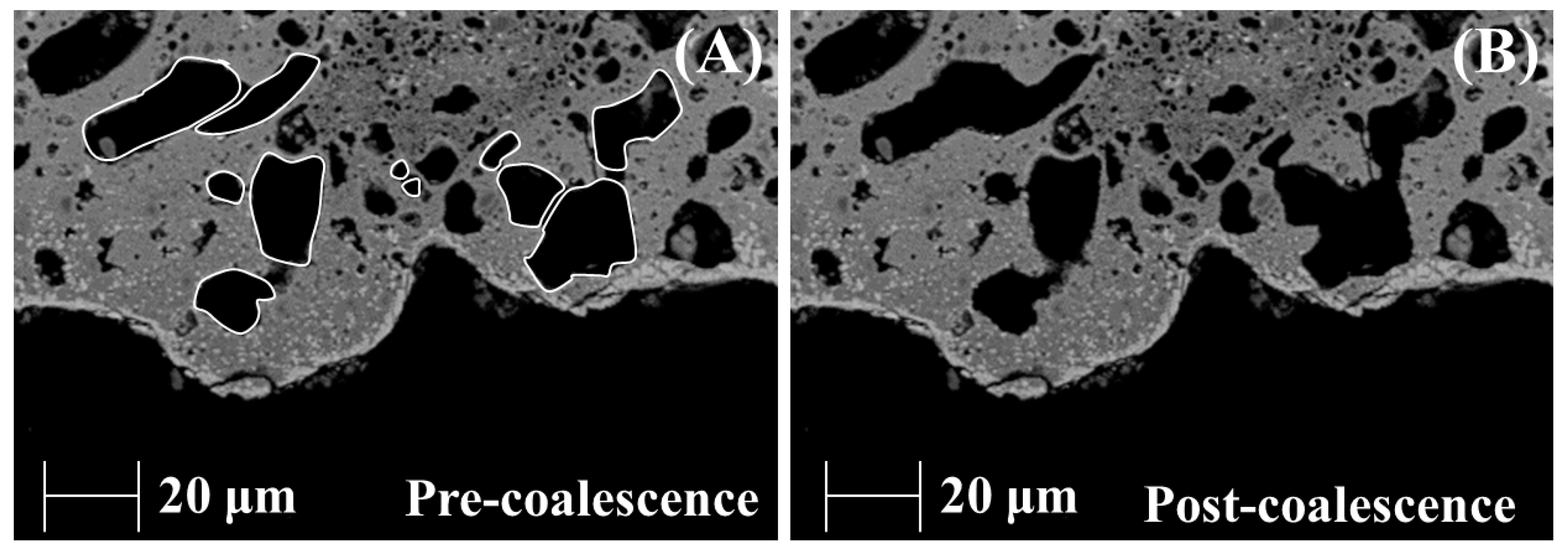Textural Study of Vesicles in Tagish Lake (C2-ung) Meteorite Fusion Crust: Constraints on Vesicle Formation during Their Entry into the Earth’s Atmosphere
Abstract
:1. Introduction
2. Materials and Methods
3. Results I
3.1. Vesicle Texture Analysis
3.2. Vesicle Size Distribution (VSD)
4. Discussion
5. Conclusions
Author Contributions
Funding
Data Availability Statement
Acknowledgments
Conflicts of Interest
References
- Genge, M.J.; Grady, M.M. The fusion crusts of stony meteorites: Implications for the atmospheric reprocessing of extraterrestrial materials. Meteorit. Planet. Sci. 1999, 34, 341–356. [Google Scholar] [CrossRef]
- Dias, B.; Turchi, A.; Stern, E.C.; Magin, T.E. A model for meteoroid ablation including melting and vaporization. Icarus 2020, 345, 113710. [Google Scholar] [CrossRef]
- Genge, M.J.; Alesbrook, L.; Almeida, N.V.; Bates, H.C.; Bland, P.A.; Boyd, M.R.; Burchell, M.J.; Collins, G.S.; Cornwell, L.T.; Daly, L.; et al. The fusion crust of the Winchcombe meteorite: A preserved record of atmospheric entry processes. Meteorit. Planet. Sci. 2023; in press. [Google Scholar] [CrossRef]
- Llana-Funez, S.; Brodie, K.H.; Rutter, E.H.; Arkwrigt, J.C. Experimental dehydration kinetics of serpentinite using pore volumometry. J. Metamorph. Geol. 2007, 25, 423–438. [Google Scholar]
- Genge, M.J. An increased abundance of micrometeorites on Earth owing to vesicular parachutes. Geophys. Res. Lett. 2017, 44, 1679–1686. [Google Scholar] [CrossRef]
- Ramsdohr, P. Die schmelzkruste der meteorite. Earth Planet. Sci. Lett. 1967, 2, 593–598. [Google Scholar]
- Genge, M.J. Vesicle dynamics during the atmospheric entry heating of cosmic spherules. Meteorit. Planet. Sci. 2017, 52, 443–457. [Google Scholar]
- Taylor, S.; Jones, K.W.; Herzog, G.F.; Hornig, C.E. Tomography: A window on the role of sulfur in the structure of micrometeorites. Meteorit. Planet. Sci. 2011, 46, 1498–1509. [Google Scholar] [CrossRef]
- Suttle, M.D.; Genge, M.J.; Folco, L.; Van Ginneken, M.; Lin, Q.; Russell, S.S.; Najorka, J. The atmospheric entry of fine-grained micrometeorites: The role of volatile gases in heating and fragmentation. Meteorit. Planet. Sci. 2019, 54, 503–520. [Google Scholar] [CrossRef]
- Toppani, A.; Libourel, G.; Engrand, C.; Maurette, M. Experimental simulation of atmospheric entry of micrometeorites. Meteorit. Planet. Sci. 2001, 36, 1377–1396. [Google Scholar]
- Nicolau-Kuklińska, A.; Łosiak, A.I. Formation of Vesicles Within the Fusion Crust of Eucritic Meteorites. In Proceedings of the 79th Annual Meeting of the Meteoritical Society, Berlin, Germany, 7–12 August 2016; Volume 79, p. 6424. [Google Scholar]
- Scott, J.M.; Negri, M.; Faure, K.; Palmet, M.C.; Knaack, D.R.; Leybourne, M.I. Multi-zone fusion crust formation and classification of the 2004 Auckland meteorite (L6, S5, and W0). Meteorit. Planet. Sci. 2023, 58, 328–340. [Google Scholar] [CrossRef]
- Brown, P.G.; Hildebrand, A.R.; Zolensky, M.E.; Grady, M.; Clayton, R.N.; Mayeda, T.K.; Tagliaferri, E.; Spalding, R.; MacRae, N.D.; Hoffman, E.L.; et al. The fall, recovery, orbit, and composition of the Tagish Lake meteorite: A new type of carbonaceous chondrite. Science 2000, 290, 320–325. [Google Scholar] [CrossRef] [PubMed]
- Yokoyama, T.; Nagashima, K.; Nakai, I.; Young, E.D.; Abe, Y.; Aléon, J.; Alexander, C.M.O.; Amari, S.; Amelin, Y.; Bajo, K.I.; et al. Samples returned from the asteroid Ryugu are similar to Ivuna-type carbonaceous meteorites. Science 2022, 379, eabn7850. [Google Scholar]
- Zolensky, M.E.; Nakamura, K.; Gounelle, M.; Mikouchi, T.; Kasama, T.; Tachikawa, O.; Tonui, E. Mineralogy of Tagish Lake: An ungrouped type 2 carbonaceous chondrite. Meteorit. Planet. Sci. 2002, 37, 737–761. [Google Scholar] [CrossRef]
- Bland, P.A.; Cressey, G.; Menzies, O.N. Modal mineralogy of carbonaceous chondrites by X-ray diffraction and Mössbauer spectroscopy. Meteorit. Planet. Sci. 2004, 39, 3–16. [Google Scholar] [CrossRef]
- Gilmour, C.M.; Herd, C.D.K.; Cloutis, E.A.; Cuddy, M.; Mann, P. Water abundance in the Tagish Lake meteorite from TGA and IR spectroscopy: Evaluation of aqueous alteration. In Proceedings of the 47th Lunar and Planetary Science Conference, The Woodlands, TX, USA, 21–25 March 2016; p. 1765. [Google Scholar]
- Shea, T.; Houghton, B.F.; Gurioli, L.; Cashman, K.V.; Hammer, J.E.; Hobden, B.J. Textural studies of vesicles in volcanic rocks: An integrated methodology. J. Volcanol. Geotherm. Res. 2010, 190, 271–289. [Google Scholar]
- Larson, M.A.; Randolph, A.D. Size distribution analysis in continuous crystallization. In Crystallization from Solutions and Melts; Springer: Berlin/Heidelberg, Germany, 1969; Volume 65, pp. 1–13. [Google Scholar]
- Marsh, B.D. Crystal size distribution (CSD) in rocks and the kinetics and dynamics of crystallization: I. Theory. Contrib. Mineral. Petrol. 1988, 99, 277–291. [Google Scholar] [CrossRef]
- Cross, J.K.; Roberge, J.; Jerram, D.A. Constraining the degassing processes of Popocatépetl Volcano, Mexico: A vesicle size distribution and glass geochemistry study. J. Volcanol. Geotherm. Res. 2012, 225, 81–95. [Google Scholar]
- Morgan, D.; Jerram, D.A. On estimating crystal shape for crystal size distribution analysis. J. Volcanol. Geotherm. Res. 2006, 154, 1–7. [Google Scholar]
- Higgins, M.D. Measurement of crystal size distributions. Am. Mineral. 2000, 85, 1105–1116. [Google Scholar] [CrossRef]
- Higgins, M.D. Closure in crystal size distributions (CSD), verification of CSD calculations, and the significance of CSD fans. Am. Mineral. 2002, 87, 171–175. [Google Scholar] [CrossRef]
- Higgins, M.D.; Chandrasekharam, D. Nature of sub-volcanic magma chambers, Deccan province, India: Evidence from quantitative textural analysis of plagioclase megacrysts in the Giant Plagioclase Basalts. J. Petrol. 2007, 48, 885–900. [Google Scholar]
- Klug, C.; Cashman, K.V.; Bacon, C. Structure and physical characteristics of pumice from the climactic eruption of Mount Mazama (Crater Lake), Oregon. Bull. Volcanol. 2002, 64, 486–501. [Google Scholar]
- Houghton, B.F.; Hobden, B.J.; Cashman, K.V.; Wilson, C.J.N.; Smith, R.T. Large-scale interaction of lake water and rhyolitic magma during the 1.8 ka Taupo eruption, New Zealand. In Explosive Subaqueous Volcanism; Geophysical Monograph Series; American Geophysical Union: Washington, DC, USA, 2003; Volume 140, pp. 97–109. [Google Scholar]
- Blower, J.D.; Keating, J.P.; Mader, H.M.; Phillips, J.C. Inferring volcanic degassing processes from vesicle size distributions. Geophys. Res. Lett. 2001, 28, 347–350. [Google Scholar]
- Orsi, G.; Gallo, G.; Heiken, G.; Wohletz, K.; Yu, E.; Bonani, G. A comprehensive study of pumice formation and dispersal: The Cretaio Tephra of Ischia (Italy). J. Volcanol. Geotherm. Res. 1992, 53, 329–354. [Google Scholar]
- Klug, C.; Cashman, K.V. Permeability development in vesiculating magmas: Implications for fragmentation. Bull. Volcanol. 1996, 58, 87–100. [Google Scholar]
- Mangan, M.T.; Cashman, K.V. The structure of basaltic scoria and reticulite and inferences for vesiculation, foam formation, and fragmentation in lava fountains. J. Volcanol. Geotherm. Res. 1996, 73, 1–18. [Google Scholar] [CrossRef]
- Pieters, C.M.; Noble, S.K. Space weathering on airless bodies. J. Geophys. Res. Planets. 2016, 121, 1865–1884. [Google Scholar]
- Noguchi, T.; Matsumoto, T.; Miyake, A.; Igami, Y.; Haruta, M.; Saito, H.; Hata, S.; Seto, Y.; Miyahara, M.; Tomioka, N.; et al. A dehydrated space-weathered skin cloaking the hydrated interior of Ryugu. Nat. Astron. 2023, 7, 170–181. [Google Scholar] [CrossRef]






Disclaimer/Publisher’s Note: The statements, opinions and data contained in all publications are solely those of the individual author(s) and contributor(s) and not of MDPI and/or the editor(s). MDPI and/or the editor(s) disclaim responsibility for any injury to people or property resulting from any ideas, methods, instructions or products referred to in the content. |
© 2024 by the authors. Licensee MDPI, Basel, Switzerland. This article is an open access article distributed under the terms and conditions of the Creative Commons Attribution (CC BY) license (https://creativecommons.org/licenses/by/4.0/).
Share and Cite
Shehaj, X.; Caporali, S.; Palomba, E.; Pratesi, G. Textural Study of Vesicles in Tagish Lake (C2-ung) Meteorite Fusion Crust: Constraints on Vesicle Formation during Their Entry into the Earth’s Atmosphere. Minerals 2024, 14, 99. https://doi.org/10.3390/min14010099
Shehaj X, Caporali S, Palomba E, Pratesi G. Textural Study of Vesicles in Tagish Lake (C2-ung) Meteorite Fusion Crust: Constraints on Vesicle Formation during Their Entry into the Earth’s Atmosphere. Minerals. 2024; 14(1):99. https://doi.org/10.3390/min14010099
Chicago/Turabian StyleShehaj, Xhonatan, Stefano Caporali, Ernesto Palomba, and Giovanni Pratesi. 2024. "Textural Study of Vesicles in Tagish Lake (C2-ung) Meteorite Fusion Crust: Constraints on Vesicle Formation during Their Entry into the Earth’s Atmosphere" Minerals 14, no. 1: 99. https://doi.org/10.3390/min14010099




